The subtleties of the process of wall insulation

Winter can bring pleasant emotions. But only if you can enter the house and enjoy its warmth. To do this without unnecessary heating costs, you need to take care of the thermal protection of your home in advance.
Peculiarities
Wall insulation is significantly different from the work of retaining heat with a floor or ceiling. Much less often resort to the use of bulk materials. It is necessary to take measures to ensure that the loose substance does not cake under its own weight. The thickness of the structure is critical. It shouldn't take up a lot of indoor space. The severity of the insulation block is no less significant: if it is very massive, the foundation will have to be strengthened, which will lead to its rise in price. All this means that the right choice of insulation blocks and systems is of decisive importance.


Materials (edit)
An increasing number of people are now using mineral wool. Isover... It guarantees an optimal microclimate in the living space, regardless of the heat or cold outside. Its main technological characteristics are as follows:
- thermal conductivity is 0.041 W xm xK;
- effective suppression of outside noise;
- the average density is 13 kg per 1 cubic meter. m;
- absolute protection from fire;


- reliable protection against condensation (provided that a gap for moisture removal is at least 20 mm);
- the minimum time of stable operation is 50 years;
- perfect sanitary and environmental safety.
If the wall cannot bear a significant load, it is quite practical and convenient to insulate it with Isover. This solution allows you to guarantee full cover from the cold, no matter what construction material is used. If the outside air temperature reaches extreme positive or negative values, the thermal insulation will retain its basic qualities. But Isover should not be taken as a universal solution. Like any mineral wool, it can have a detrimental effect on the human body and animals.

Material with various characteristics is supplied under this brand. It:
- lightweight structures;
- general construction soft slabs and mats;
- mineral insulation for a pitched roof.
Installation of insulation for a cinder block house is strictly required. There is little joy when it comes to cold housing. A considerable part of craftsmen and amateur builders are trying to insulate constructions made of cinder block with polystyrene foam. It allows little heat to pass through and is quite mechanically strong, although it has a low density. What is very useful, there is no need to spend money and time installing a waterproofing membrane.


Polyfoam has good antiseptic properties. It is not difficult to acquire it for people with any income level. But there is a serious limitation: the likelihood of fire. Initially, a primer will have to be applied to ensure maximum adhesion to the substrate.
A prerequisite for success will be the installation of fiberglass reinforcement mesh. This mesh is of two types: for internal and external reinforcement. It is undesirable to confuse these types.
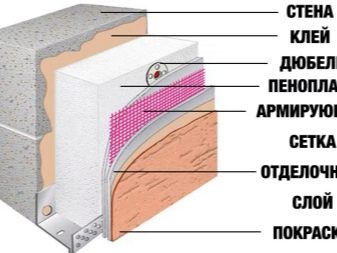

Insulation also has its own characteristics. aerated concrete walls... Aerated concrete blocks contain a lot of gas bubbles (hence the name). They must be insulated in any case, regardless of production in an autoclave or without it.For aerated concrete, a number of heaters have been invented, but more than other options, the popular varieties are polystyrene and polyurethane foam. The second material is considered more reliable and modern. But its application without the help of a team with special equipment is impossible. Polyfoam and polyurethane foam are less durable, but the owners of the houses themselves can use them.


Aerated concrete can be insulated from frost and simple mineral wool. But this should only be done as a last resort. The ability of cotton wool to concentrate water vapor will negatively affect the properties of the blocks. Such houses will also have to be insulated from the inside. For this purpose, experts recommend using plaster mixes. Moreover, it is the internal work on insulation that precedes the external, and not vice versa.


In many cases, builders use stone wool. This material has really earned its reputation. It is obtained from basalt, metamorphic rocks, marl. Usually, construction firms purchase the basalt version for the most demanding projects. But it is equally important to take into account the acidity level. The less alkalinity of the cotton wool insulation is, the harder it is and the longer it will work.
To increase water resistance, phenol-formaldehyde resins and other additives are added to stone wool. Therefore, it is important to find out what the exact chemical composition of the mixture is, so as not to face sudden toxic effects. Although the stone wool itself will not ignite even when heated to 1000 degrees, its binders will evaporate already at 200. Therefore, in the event of a fire or other emergency, the entire insulation will have to be removed and replaced with a new one.


The advantage of such thermal insulation is the fact that all excess moisture leaves the rooms or work premises without lingering in the insulation. As for the negative points, here you need to remember the abundant dusting and the inevitably high price of products. When buying material, you should pay attention to the conditions of its storage. You cannot buy cotton wool outside the original container and without shrink film. It is recommended to check the packaging so that there is no leakage. It is unacceptable to store material outdoors without a canopy or awning. When stored in cardboard boxes, technological requirements prohibit placing them where there is at least negligible dampness.
Schemes
Insulation of a concrete wall of a house from the inside is practiced in cases where it is impossible to carry out external work. Concrete creates many difficulties and problems in winter, and in apartments it is almost always insulated inside. The services of industrial climbers or lifting equipment are very expensive. In addition, the housing inspectorate almost never considers a project for selective thermal protection of a single apartment. Doing work without approval means facing a wave of fines or homelessness for arbitrariness.


The easiest way to keep warm in a concrete house is with plaster. But it does not always give a decent effect. In the coldest regions or even the corner of the house, the microclimate will not return to normal. The first steps in any case are the exposure of the structural surface and antiseptic treatment. Then you will have to wait for the substrate to dry completely. Insulating plaster is made in three stages:
- splashing;
- primer layer;
- cover (external decorative coating).

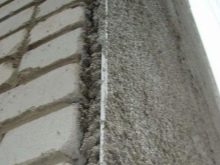

The initial thin layer is a solution of 1 part of cement and 4 (5) parts of well-sieved sand. This solution must have a liquid consistency in order to adhere to the surface. Layout is done with a hard trowel. Apply force, trying to penetrate the solution deeper into the pores of the base. The total thickness of the first layer can reach 1 cm, it must be done evenly over the entire surface.


The priming layer is created using typical cement plasters of the corresponding category. But it is better already at this stage to make a choice in favor of a material with a reduced thermal conductivity.The primer is applied in a layer of 5 to 6 cm, and it is created in three steps. Each subsequent treatment is carried out only after the end of the drying of the already applied material. Next, you need to make the top coat (no thicker than 0.5 cm).
Covering solution - finishing putty, diluted with water to a liquid state. The work is carried out by rubbing this solution into the primer. When the treated surface dries, it is further improved by troweling and sanding. If such a solution is not effective enough, you will have to revet the concrete wall with foam.
As in the previous case, antiseptics are indispensable.


The dried disinfected wall is covered with a finishing liquid putty with a layer of 0.5-1 cm to level the surface. Then, in any case, lay the waterproofing layer with a layer of 3 to 5 mm. Foam plastic is glued with a specialized powder composition, which is stirred in water 90-120 minutes before starting work, turning it into a thick homogeneous lump. You need to glue the entire wall evenly, the sheets themselves are enough only in the center. Gluing is done with slight pressure, the joints must be tight.
After gluing the sheets, the seams must be covered with putty or polyurethane foam. The final hardening of the glue, depending on its formulation and working conditions, occurs 48-96 hours after application. You can strengthen the attachment to the wall with plastic dowels. The final plastering of the foam is carried out along the polymer mesh. It should be embedded in glue, covered with finishing plaster (must be trowelled and sanded).


Technically attractive is the insulation of concrete with fibrous materials, including mineral wool. Under it, you will have to create a frame made of wood impregnated with antiseptic drugs. The rails must be fastened vertically (from the top to the bottom points of the wall), the distance between the lines is approximately 0.6 m. The material must be attached to the rails with anchors, drilling 3 holes in each wooden part.


To do this, take a drill with a diameter of 0.8 cm.The rails themselves are held with screws on concrete. The gaps between the slats are supposed to be laid with roofing material. Above it is a cotton layer. The insulation is laid in 2 or 3 levels, a foil film insulating steam is placed above it. It is pressed against the slats on the construction brackets. The insulating block is closed from above for decorative purposes:
- drywall;
- particle board;
- plywood.

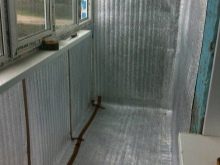

In private construction, the popularity of brick construction of houses is great. They are even more popular than concrete ones, since they are not inferior to them in strength, keep warm better and are more aesthetic. But the thermal qualities of the best grade of bricks are not enough to protect against Russian frosts. So that condensation does not drip from the inside of the wall, and cold drafts do not walk around the house, you can apply:
- expanded clay;
- mineral wool;
- penoplex;
- Styrofoam;



- expanded polystyrene;
- insulating plaster;
- EPPS;
- cork;
- ecological wool.
External insulation with polyurethane foam is carried out on a frame made of wood or metal. The same material is also suitable for internal thermal protection. If the house is still only planned to be built, you can lay in the interior brickwork in the project. This step is no worse than special plates or rolls. First of all, they put an external wall, raise it up to 150 cm, and steel rods are successively introduced into the seams of the fifth or sixth rows. Immediately after this, tiles or sheets of thermal protection are mounted, and an internal brick row is laid.


When thermal insulation is achieved due to expanded clay, the outer inner walls are raised up to 150 cm, which are separated by an interval of about 0.15 m. From this point, construction is carried out to the upper planned line. If you plan to insulate the house from the outside, this work is first carried out with a foundation and a plinth.The outer wall is thoroughly cleaned, only under this condition will the finishing be an effective measure. Extruded PPS or polystyrene is placed outside, initially leveling the walls with plaster and priming them.
The insulation is placed using glue or steel dowels. Installation is carried out from the bottom up in a checkerboard pattern to increase the stability of the structure. If the creation of a ventilated facade is planned, they begin by attaching a vapor barrier block, on top of which a frame is placed. A wadded insulation is placed in this frame, which is additionally covered with a hydro-barrier. All three insulating materials are attached with dowels.
The typical exterior finish in this case is siding.


Internal insulation with foam or EPS brick is not very practical. These materials are poisonous and burn easily. Antiseptic primers are applied before insulation begins; they effectively suppress fungal aggression. Waterproofing and protection by overhangs from precipitation for silicate bricks should be more careful and thoughtfulthan for an ordinary ceramic block. It is recommended to use concrete with expanded clay additive for masonry. Its thermal conductivity will immediately drop by 50%.
Putting expanded clay inside the walls will be most effective when choosing a large fraction (this will reduce the load on the foundation).


When it is impossible to insulate a brick wall outside or in the middle in any way, materials with the least permeability to water vapor are taken for internal insulation. Most often it is EPS or penofol with an outer foil sheath. It is only important not to confuse which side of these materials should be mounted inside the room. If you have to use a material that allows a lot of vapors to pass through, it will need to be covered with a water vapor-impermeable film or a thin foam foam shell.
In case of the slightest difficulty, it is more correct to entrust the insulation of a brick wall to professionals. There are some subtleties in the insulation of the walls of a frame dwelling. Glassine is widely used for waterproofing such buildings; heaters are taken only with foil to reduce steam escape. Typical insulation solutions are polyurethane, foam and mineral wool.
You will definitely have to make a crate from edged boards with a moisture content of no more than 15%. The recommended cross-section of lathing fragments is 2.5x15 cm.


Insulating blocks are inserted into the gaps between the frame posts. Sprayed insulation is underestimated by home owners in vain. They give excellent results in frame constructions and can be applied without the help of a professional team. The hardened polyurethane needs to be reworked (remove excess fragments and sand the surface). Due to the elimination of joints and seams, heat loss will be minimal.
In old houses, the walls inside often have many cavities or one large cavity. As a result, the owners and tenants suffer from the freezing room, nothing can be done with it. Cavities can also arise due to errors in the installation of insulation or due to its natural degradation over time. Such troubles can be eliminated by ensuring the introduction of thermal insulation through the holes made in the outer wall.
Since such manipulations are responsible and, in case of mistakes, can even lead to the destruction of the house as a whole, you should definitely contact professionals.


In regions where there is a lot of precipitation, it is unacceptable to use mineral wool and basalt insulation, including for closing voids, cavities. You can not use expanded clay. Where better proved itself in such harsh conditions according to the operating experience of polyurethane foam. To find out if there is a cavity in the walls of a cold room that can be "blown out" with a liquid or sprayed material, a standard plan will help.In the absence of a plan, with its inaccuracy or obvious mistakes, technological holes are made in the seams and the wall behind them is checked with wire movements. More gentle options - calling professionals with a thermal imager or self-scanning structures with this device.
But the cold also reaches the residents of apartment buildings, in the load-bearing walls of which there are weak seams. For the most part, the seam elements of panel structures are provided with an additional insulating layer from the outside, since it is ineffective to do this from the inside. In any case, before starting work, you should carefully study the technical regulations and building codes. If it is not possible to mount the insulation from the outside, its internal version must be covered with an unbreakable, long-lasting vapor barrier.
It is recommended to insulate joints in panel houses with elastic materials to compensate for possible thermal expansion.


Most often, experts take for such purposes:
- foamed polyethylene "Vilaterm";
- polyurethane polyurethane foam "Macroflex" (or similar foamed polyurethanes);
- non-precipitating sealants (for example, "Sazilast 24").


In houses operated for a long time, the sequence of work consists of several stages:
- opening the old seam;
- dismantling the existing protection;
- Rust's amendments in case of urgent need;
- removing dust and dirt;
- filling the space with polyurethane foam;


- attachment to the fresh layer of its heat-insulating tubes;
- adding foam to areas where it initially went unevenly;
- cutting off the hardened foam;
- waterproofing.
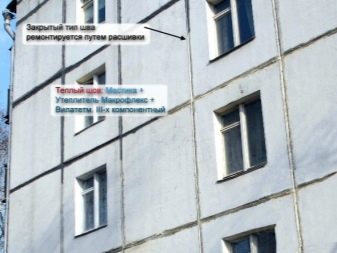

Cross insulation is suitable for frame buildings. Heat-saving mats are applied so that the seams do not coincide with each other. Then the occurrence of wind-blown crevices is excluded. Frost bridges are guaranteed to overlap (wooden parts). The fight against them will be successful if you add another 5 cm of insulation at problem points above the 15 cm heat shield outside.
Placing 5x5 cm bars horizontally outside the frame will be the first step. The distance between each pair of bars should be 10 mm less than the width of the insulation block. The block itself is put strictly by surprise. Immediately after installation of all insulation parts, it is supposed to close them with moisture protection. It will cover the material from the wind and prevent it from falling out.
It is strictly not allowed, even for corners, to ram the thermal protection and push the material by force inward. After all, the main properties of mineral wool are given by the air contained in it. Violating the integrity of the insulator, it will not be possible to keep it inside. Therefore, the house will be colder than the residents expect. The basement floor is insulated almost according to the described scheme.


How to choose?
Now you need to find out which insulation material is better. There is no universal answer to this question. But there are some things to keep in mind. Carrying out a full-fledged thermal calculation without special knowledge is not possible: ready-made online calculators will hardly help or even mislead. When analyzing the properties of each coating, the following are analyzed sequentially:
- steam capacity;
- heat exchange efficiency;
- fire and chemical safety;
- the load created by the insulating layer.


Stone walls are optimally combined with mineral wool and its analogues. Even weaker thermal protection compared to the leading products on the market is justified by the superior cost and lightness, as well as the ease of installation. The mineral variant is soft and has an average thermal conductivity. Cotton wool with the addition of basalt crumbs shows itself more reliably. But manufacturers take extra money for this. Such material is especially good in areas close to stoves and fireplaces.
Problems with cotton wool are due to its weak ability to hold its shape. By accumulating moisture, the insulation becomes heavy and sags. The way out is to increase the frequency of bindings in comparison with their recommended placement. Thermal insulation of wooden or frame buildings with wadded materials is not very practical. They come in handy in cases where the walls need very little additional insulation. Styrene and substances based on it are better shape-saving and resistant to temperature jumps.
Excellent heat capacity allows for intensive thermal protection of thin walls.


Among the foam, it is recommended to choose products under the SPB-S marking, indicating the addition of fire retardants. If they are not there, it is better not to use such material at all. Penoplex is recommended for insulating roof junctions. Penoplex should be used to sheathe walls from the inside. There he will absorb quite a bit of space.
Preparatory work
If the wall insulation for one reason or another is planned to be carried out from the inside, preparation consists of:
- maximum drying of the surface;
- installation of vapor barrier;
- laying of waterproofing.
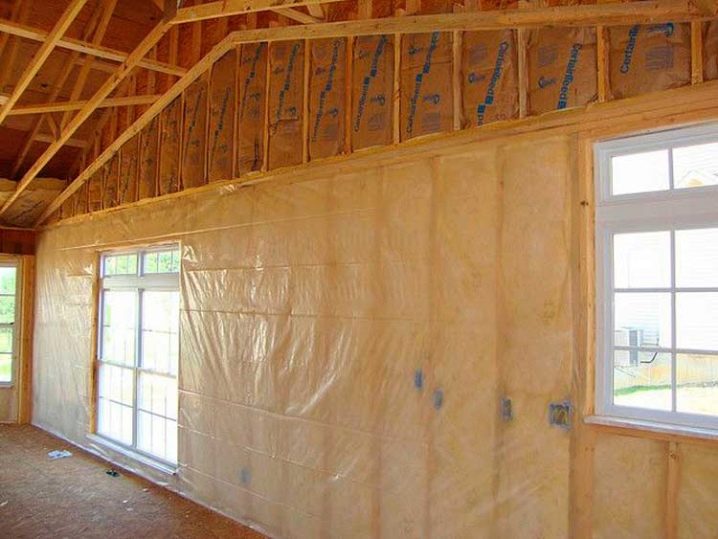
It is better to mount the formwork before applying the foam. It will allow you to keep the surface as flat as possible and make the layer especially reliable. The frame is covered (wrapped) with heat-insulating material, otherwise it will turn into an entrance gate for frost. If a brick wall is finished, everything is removed from it (up to the very base). The approach to concrete is similar. Dirt is removed with a vacuum cleaner, visible fungal lesions can be easily eliminated by treating the surface with brushes and sandpaper.
How to insulate with your own hands?
Step-by-step instructions for installing polystyrene foam insulation are simple. Such material is recommended for laying on wood, brick, fastening is performed in the same way. The dry method is used for a limited time. The wet technique requires the introduction of the material into the wall grooves and its natural drying for 48-72 hours. Under sharply unfavorable meteorological conditions, these periods increase noticeably.
Only perfectly flat walls are suitable for expanded polystyrene. This material is fragile. If you begin to fit it to a surface with significant relief, the plates can crack. It is advisable to eliminate all differences greater than 3 mm. Low vapor permeability paint will have to be removed. For fastening, you need to use special glue. You will definitely need to apply a primer.

Tips & Tricks
If it is decided to use mineral wool, it is worthwhile to dwell on the modification Line Rock... It guarantees environmental friendliness and excellent noise insulation. When choosing different materials, you should immediately clarify:
- their total length and width;
- the possibility of slicing;
- desired ways of joining.
It is necessary to wait about 4 hours after applying the primer, even if the manufacturer promises faster drying. When asking for help from hired installers, you should carefully monitor how many dowels and glue they actually use.

Do not overpay for a "famous" product. Better to spend the extra time getting to know the practical characteristics of dissimilar products and how they are being reviewed.
For information on how to insulate a house with foam plastic with your own hands, see the next video.













The comment was sent successfully.